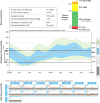Continuous Glucose Monitoring: A Brief Review for Primary Care Practitioners
- PMID: 30659511
- PMCID: PMC6824352
- DOI: 10.1007/s12325-019-0870-x
Continuous Glucose Monitoring: A Brief Review for Primary Care Practitioners
Abstract
Glycated hemoglobin A1c (HbA1c) is routinely used as a marker of average glycemic control, but it fails to provide data on hypoglycemia and glycemic variability, both of which are associated with adverse clinical outcomes. Self-monitoring of blood glucose (SMBG), particularly in insulin-treated patients, is a cornerstone in the management of patients with diabetes. SMBG helps with treatment decisions that aim to reduce high glucose levels while avoiding hypoglycemia and limiting glucose variability. However, repeated SMBG can be inconvenient to patients and difficult to maintain in the long term. By contrast, continuous glucose monitoring (CGM) provides a convenient, comprehensive assessment of blood glucose levels, allowing the identification of high and low glucose levels, in addition to evaluating glycemic variability. CGM using newer detection and visualization systems can overcome many of the limitations of an HbA1c-based approach while addressing the inconvenience and fragmented glucose data associated with SMBG. When used together with HbA1c monitoring, CGM provides complementary information on glucose levels, thus facilitating the optimization of diabetes therapy while reducing the fear and risk of hypoglycemia. Here we review the capabilities and benefits of CGM, including cost-effectiveness data, and discuss the potential limitations of this glucose-monitoring strategy for the management of patients with diabetes. FUNDING: Sanofi US, Inc.
Keywords: Continuous glucose monitoring; Diabetes; Flash glucose monitoring; Glycemic variability; HbA1c; Hypoglycemia.
Conflict of interest statement
Ramzi Ajjan has received institutional research grants from Abbott, Bayer, Eli Lilly, Novo Nordisk, Roche, and Takeda and has received honoraria/education support and served as a consultant for Abbott, AstraZeneca, Bayer, Boehringer Ingelheim, Bristol-Myers Squibb, Eli Lilly, GlaxoSmithKline, Merck Sharp & Dohme, Novo Nordisk, and Takeda. David Slattery has no conflicts of interest to declare. Eugene Wright has participated in the speakers’ bureau of Abbott Diabetes, Boehringer Ingelheim, and Eli Lilly, has served as a board member/advisory panel member for Abbott Diabetes, Boehringer Ingelheim, Eli Lilly, Voluntis, Sanofi, and PTS Diagnostics, and has served as a consultant for Abbott Diabetes, Boehringer Ingelheim, Eli Lilly, and Voluntis.
Figures


Comment in
-
Letter to the Editor Regarding: Continuous Glucose Monitoring in Type 2 Diabetes Mellitus Patients in Primary Care.Adv Ther. 2020 Mar;37(3):1276-1278. doi: 10.1007/s12325-020-01234-z. Epub 2020 Jan 29. Adv Ther. 2020. PMID: 31997240 Free PMC article. No abstract available.
References
-
- Diabetes Control and Complications Trial/Epidemiology of Diabetes Interventions and Complications Research Group. Lachin JM, Genuth S, Cleary P, Davis MD, Nathan DM. Retinopathy and nephropathy in patients with type 1 diabetes four years after a trial of intensive therapy. N Engl J Med. 2000;342:381–389. doi: 10.1056/NEJM200002103420603. - DOI - PMC - PubMed
Publication types
MeSH terms
Substances
Associated data
LinkOut - more resources
Full Text Sources
Other Literature Sources
Medical

